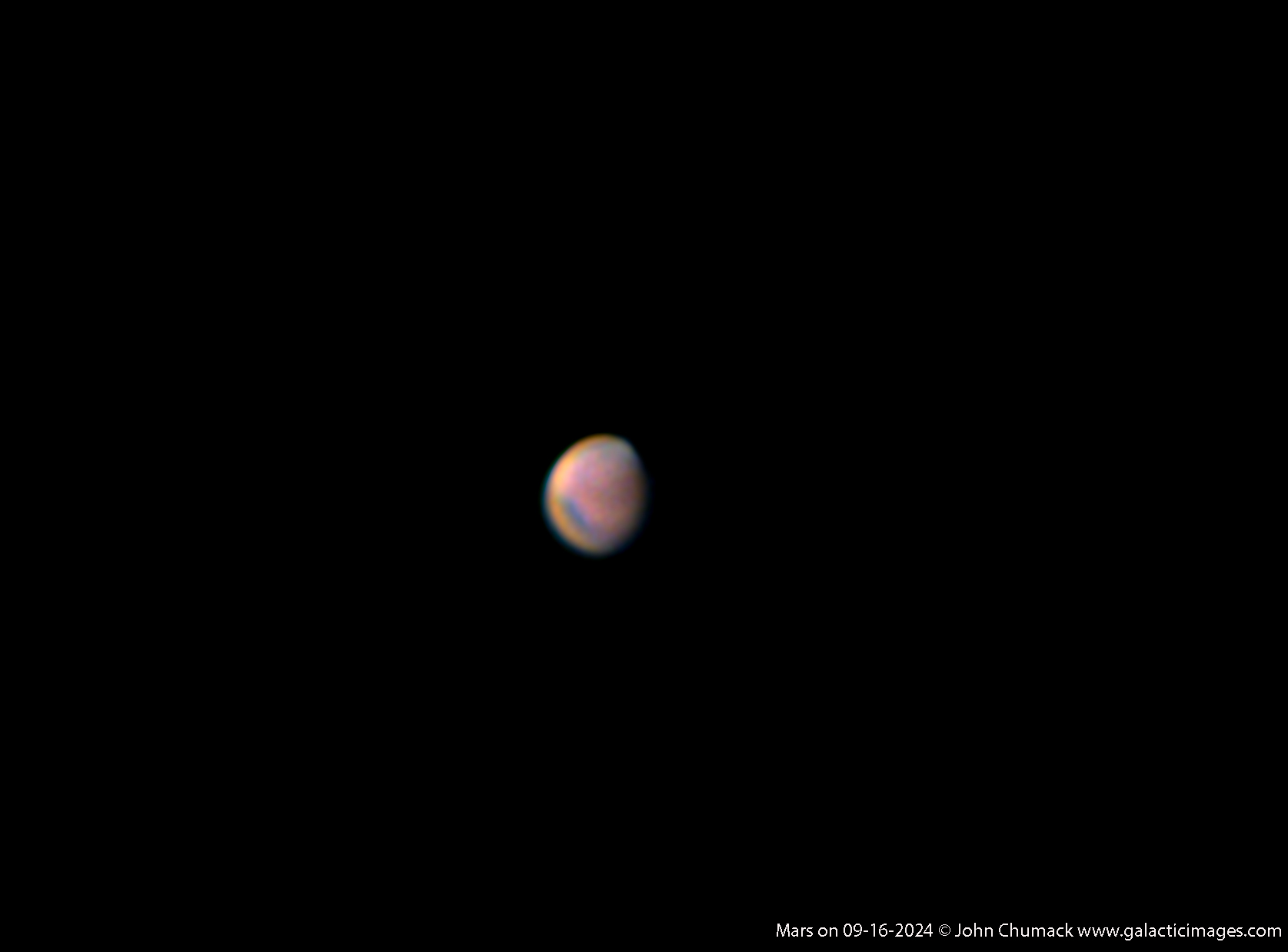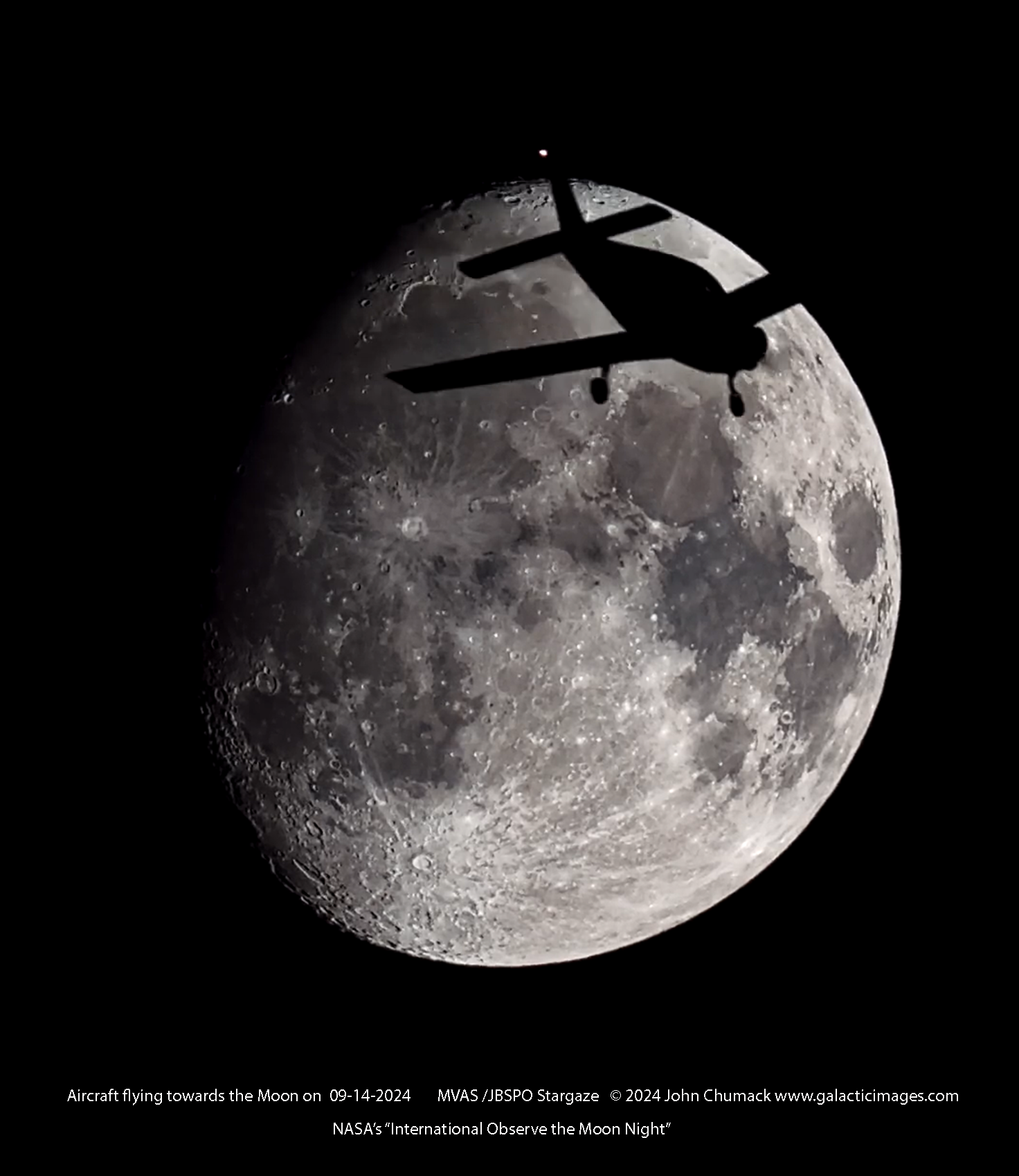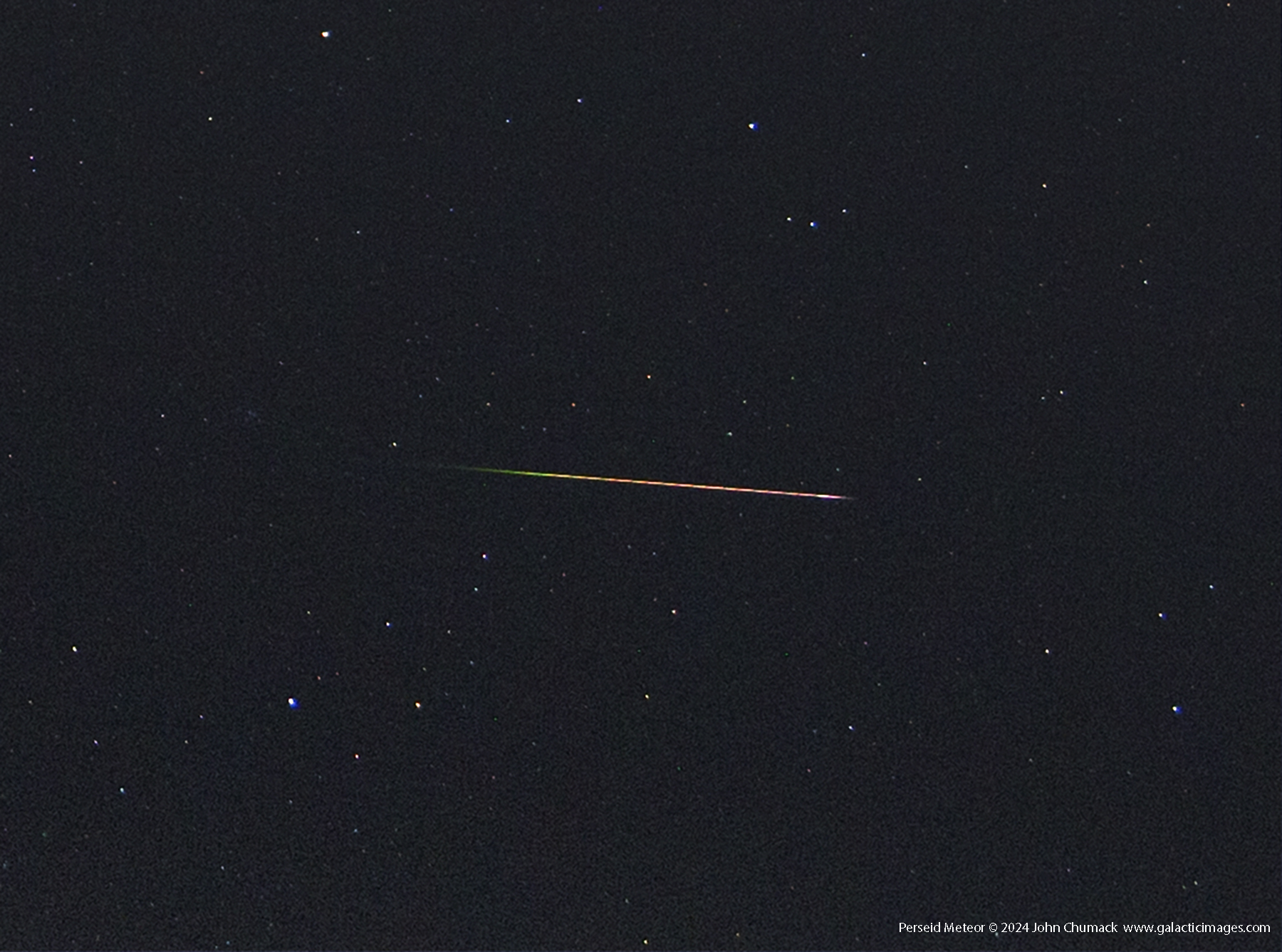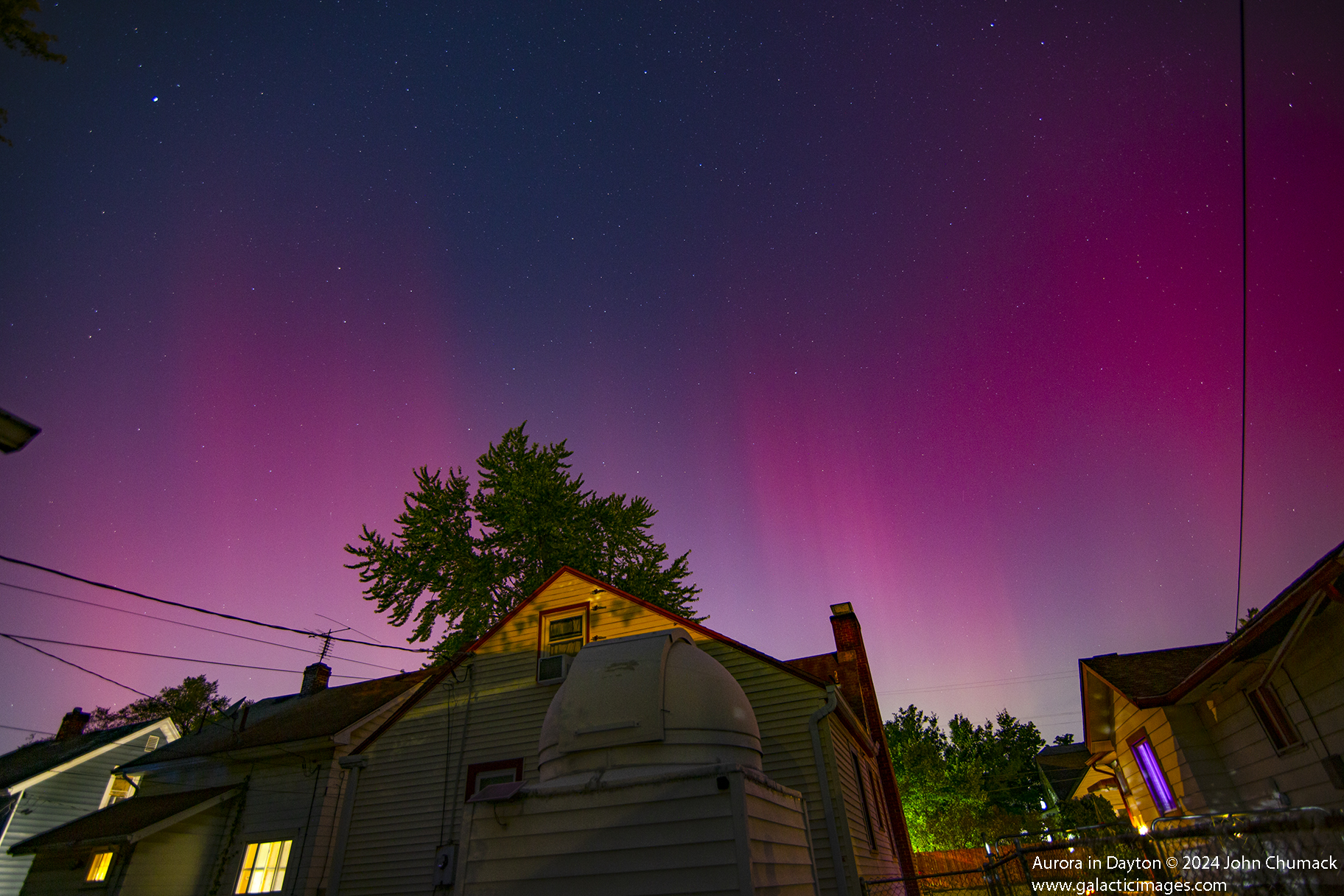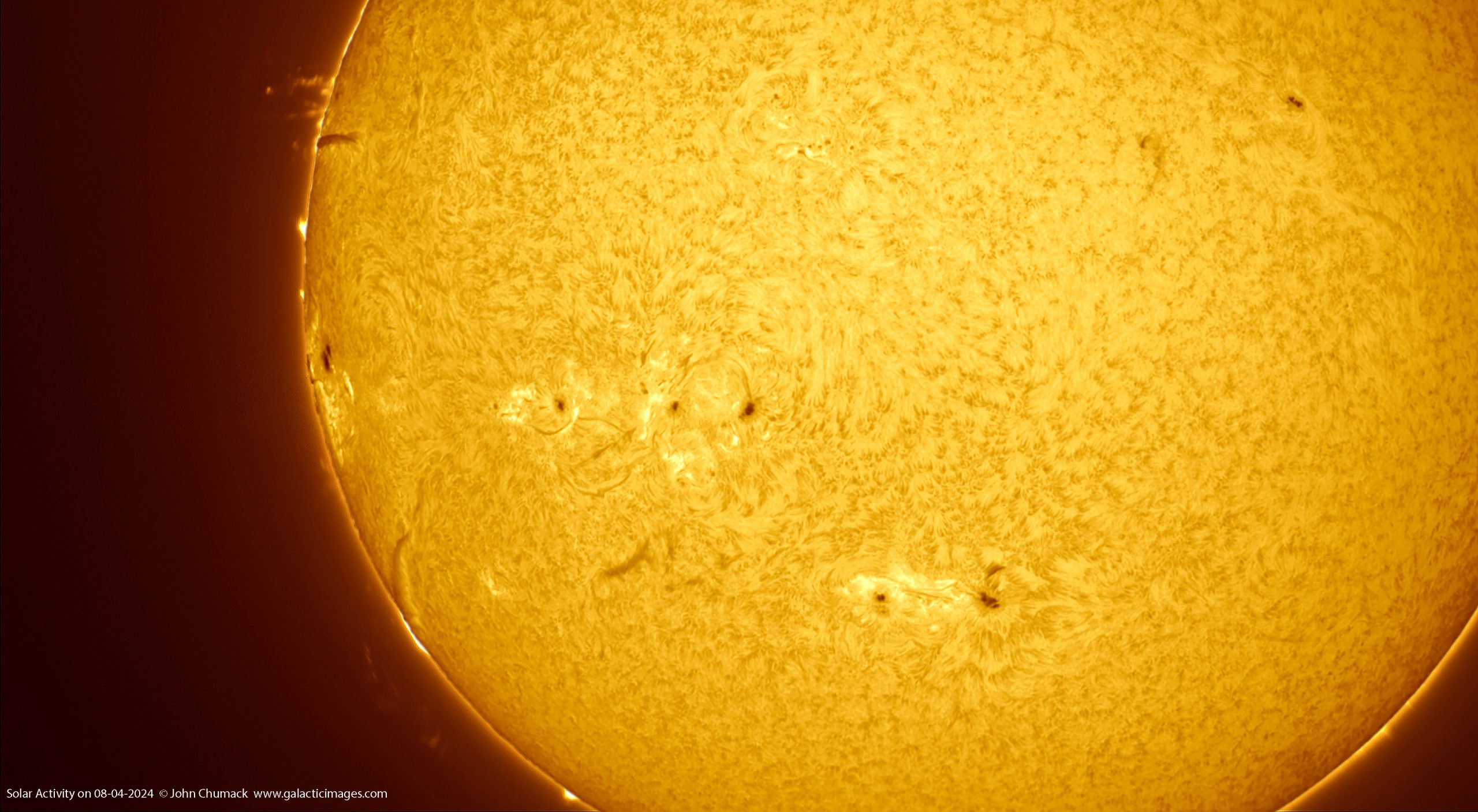Jupiter and the Jovian Atmosphere on 10-08-2024
Had some good stable seeing early this morning from my backyard in Dayton, Ohio.
Jupiter on 10-08-2024 at 10:24 UT
My old Orange tube C-11 Telescope, Bisque MyT Mount, QHY462MC Cmos Camera, 2.5x barlow, ADC,
Fire-Capture Software, 6ms exposures, SER Video File, 9,000 frames stacked.
Astrosurface, Registax6, Adobe Raw CC 2025
Best Regards,
John Chumack
www.galacticimages.com
The Planet Mars on 09-16-2024
Here is a shot of Mars that I captured in the early morning of 16 September 2024 at 09:23 UT, while it was only 7 arc seconds across, and the lit phase was only 41%.
You can see the North Polar Cap shrouded in clouds, at the bottom you can see the darker surface feature of Terra Meridiani.
Despite its tiny size at the moment, there are still larger details to be seen and captured. Mars is currently shining at 0.54 magnitude
Light takes 10 minutes and 38.9422 seconds to travel from Mars and arrive to us.
The distance of Mars from Earth is currently 119,023,676.728 miles (191,550,040 kilometers).
This image was captured from my backyard observatory in Dayton, Ohio with my C-11 SCT scope, Bisque MyT Robotic Mount, QHY462mc Cmos color Camera, 2x Barlow, ADC, Captured with Fire-Capture Software as a SER Video File, 4ms exposure, stacked 6000 frames out of 14,000, Astrosurface, Registax6, and Adobe Raw CC 2025.
Best Regards,
John Chumack
www.galacticimages.com
A Piper Warrior Airplane flying in front of the Moon
Saturn’s Rings are tilting
Saturn’s Rings will disappear from sight in March of 2025, but only for a few months.
During Saturn’s 29.5 year orbit around our Sun, the planet Saturn presents a ring plane crossing every 14-15 years as seen from Earth.
In reality, it all has to do with planetary alignments.
As Saturn and Earth orbit the Sun, the two planets align in such way that gives us these wonderful views of
Saturn’s majestic rings and the tilting/ring plane cycle.
This is what I really like about Saturn, that every year I can look and see the rings tilted at a slightly different angle than the previous year, but when it goes edge on and vanishes, it looks really strange!!…as we are so accustomed to seeing the ring system around the planet.
Saturn’s rings are so thin (30ft up to 2 miles thick in some places) when viewed from Earth, that they seemingly vanish when viewed edge-on, due to our distance from Saturn.
The distance of Saturn from Earth is currently 1.3 billion kilometers (~ 812.5 million miles), the reflected light takes 1 hours, 12 minutes and 41.6580 seconds to travel from Saturn and arrive to us on Earth.
Now you may still see the ring’s shadow cast upon the planet’s disk, but the rings will become invisible to your eyes or cameras when looking or shooting through the telescope come March of 2025.
Capture details:
C-11 SCT telescope, ADC, 2x Barlow, QHY462C Cmos Camera,
Fire-Capture Software, SER file, 60FPS, 17 ms exposures, stacked 50% of 5,000 frames.
Astrosurface, Registax6, and Adobe Raw CC.
High haze and poor seeing, but I managed to pull this image out of the muck.
Captured from my backyard observatory in Dayton, Ohio on 08-15-2024 at 05:59 UT
Best Regards,
John Chumack
www.galacticimages.com
Perseid Meteors on 08-12-2024
Perseid Meteor on 08-12-2024
Here is a nice one…the original wider angle image shows Cassiopeia and Perseus constellations rising in the Northeastern sky above my backyard observatory dome.
The second close-up image of the Perseid Meteor.
The color of a meteor depends on its chemical composition.
Note the nice colors in my close-up shot of this Perseid Meteor.
Some common meteor colors are: Orange-yellow (sodium), Yellow (iron), Blue-green (magnesium), Violet (calcium), and Red (atmospheric nitrogen and oxygen).
These are the typical colors of meteors as they burn up entering the Earth’s atmosphere, with the meteors moving at an average speed of 133,200 mph (214,365 kph).
Best Regards,
John Chumack
www.galacticimages.com
Northern Lights Visits Dayton Ohio on 08-12-2024
While watching and capturing the Perseid Meteor shower last night, the Aurora made an appearance above my backyard Observatory in Dayton.
Aurora Borealis In Dayton, Ohio on 08-12-2024 02:00 LT. Canon 6D DSLR, 16mm F2.8, ISO 800, 5 second exposure.
Best Regards,
John Chumack
www.galacticimages.com
M27 The Dumbbell Nebula with the Seestar 50s scope
M27 The Dumbbell Nebula with the Seestar 50s scope
M27 is located 900 light years away in Vulpecula, The Dumbbell Nebula (also known as the Apple Core Nebula, Messier 27, and NGC 6853) is a planetary nebula or a dying star blowing off its outer atmosphere.
You can see this nebulosity surrounding a white dwarf in the constellation Vulpecula,
The Dumbbell Nebula is located at a distance of about 1200 light-years away from Earth.
Shining at Magnitude 7.5 it is one of the brightest PN and easily visible in any telescope and it’s diameter is about 8 Arc-minutes.
Watching for early Perseid meteors/Exhausted I fell asleep in my observing chair and when I finally woke up,
I realized that both scopes had gone for longer than I was planning, thus the field rotation reduced my FOV significantly, causing me to have to crop to the center of the chip, but the image still came out nice, even if a bit closer up than I was originally shooting for.
Captured with Two ZWO Seestars 50s Automated scopes/ZWO Sony 462 Chip cameras.
2 hour total integration time. Stacked in Nebulosity 4,
Pixinsight and Adobe Raw CC for post processing.
Captured from my backyard in Dayton, Ohio on 08/09/2024.
Best Regards,
John Chumack
www.galacticimages.com
Sunspot Activity on 08-04-2024
Here is my latest of the very active Sun on with Sunspots/Active Regions AR3769, AR3774, AR3775, AR3776, AR3777
and a very Large Sunspot/Active Region is just now coming around the Sun’s Southeastern Limb,
and it had been flaring while on the back side.
I was surprised that it came out as well as it did, considering the High amount of water vapor in the sky, plus shooting in between thick passing clouds.
Here are my shot details for the
Solar Activity on 08-04-2024.
Lunt 60mm/50F HA telescope, QHY290 Cmos camera, Bisque MyT mount, 2.3ms exposures. Fire-Capture Software,
1200 frames stacked in AS4, processed in Adobe CS Raw.
Captured from my backyard observatory in Dayton, Ohio.
Best Regards,
John Chumack
www.galacticimages.com
Lunar / Planetary/Aldebaran Conjunction on 07-31-2024
Lunar/Planetary/Aldebaran Conjunction on 07-31-2024
Just after T-storms overnight, I look East around 6:00am to see the clouds moving out…revealing the Conjunction again….and a little Pareidolia……does that cloud just to the right of Aldebaran look like a profile of Santa?…and I guess he likes looking at the conjunctions. 🤩 Captured with my I-phone from my driveway while on my way to work that morning. 7.5mm, 1/15th second exp, ISO 640.
Best Regards,
John Chumack
www.galacticimages.com
The Full Buck Moon 07-21-2024
I had been gone for the last 6 weeks, traveling to shows(working), vacation, and etc. After finishing up my Ann Arbor, Michigan show, I spent the night at my very good friend’s place in Saline, Michigan, and yes I brought the Portable Seestar scope up there with me and took this shot for them of the Full Buck Moon on 07-21-2024. Despite being wiped out from the 6 weeks of shows back to back/travel as well as the high haze and cirrus clouds floating through, I managed to get a decent shot for them.
Best Regards,
John Chumack
www.galacticimages.com



